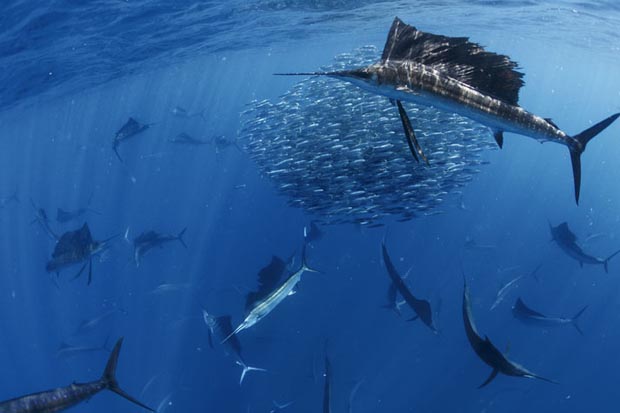August, 2015
[dropcap]A[/dropcap]cross the globe, animals are packing up and moving. Some are moving north, some are heading south, and others are just following their food. The world is changing and animals are trying to keep up, and for those in the water one tactic is to find colder water by moving away from the equator and towards the poles. But at least one group of fish on the Great Barrier Reef is employing a different strategy: rather than chasing cold water to higher latitudes, they’re moving deeper to beat the heat.
That major environmental changes modify fish behavior has been well documented. Severe storms, for example, can result in significant changes in a species’ distribution, and large temperature variations are known to alter everything from fish reproductive performance to foraging tactics. Environmental conditions like water temperature, wind, rainfall, and moon phase all influence fish movement patterns. While the fluctuations associated with climate change are likely to be large in the long term, on a day-to-day basis they’re generally quite subtle. What James Cook University marine biologist Leanne M. Currey wanted to find out was how tiny variations might affect reef fish.
To find out, she and her colleagues looked to the redthroated emperor Lethrinus miniatus, a commercially and recreationally important fish in he Western Pacific and Indian Oceans. After the coral trout, the species is second favorite for the reef fishery.
 The researchers focused their work at Heron Island Reef on the southern end of Australia’s Great Barrier Reef. There, they caught 26 of the fish using rods and reels outfitted with barbless hooks. Once landed, the fish were surgically implanted with a small acoustic transmitter, and a small identification tag was affixed to their dorsal fins. Meanwhile, an array of 25 acoustic receivers was deployed around the reef. They monitored the movements of the tagged fish around the reef over the course of an entire year. By comparing three years’ worth of the emperors’ movements with environmental data, Currey could look for the consequences of small changes in local conditions on their habitat preferences.
The researchers focused their work at Heron Island Reef on the southern end of Australia’s Great Barrier Reef. There, they caught 26 of the fish using rods and reels outfitted with barbless hooks. Once landed, the fish were surgically implanted with a small acoustic transmitter, and a small identification tag was affixed to their dorsal fins. Meanwhile, an array of 25 acoustic receivers was deployed around the reef. They monitored the movements of the tagged fish around the reef over the course of an entire year. By comparing three years’ worth of the emperors’ movements with environmental data, Currey could look for the consequences of small changes in local conditions on their habitat preferences.
Currey and her team discovered that the fish were less likely to be swimming along the reef slope when the water was warmer. Though she can’t be sure (because the acoustic transmitters could only detect the fish to a depth of 25 meters), she suspects that the fish were moving deeper in search of the cold. The fish have been found as deep as 160 meters, meaning that commercial and recreational fishing outfits will have to adapt their own tactics for finding the fish as surface waters continue to warm.
Some fish are broadly distributed, with local populations having become adapted to local conditions. Those species are perhaps more able to withstand long-term environmental changes, since they can already thrive in a variety of places. The distribution of the redthroated emperor on the other hand is fairly narrow. They’re already excluded from warmer tropical waters, which suggests that they may have a tougher time thriving in warmer seas. For now, that’s just a guess. Currey says that the next phase of her research will be to see whether the fish are physiologically capable of adapting to warmer waters at all. – Jason G. Goldman | 12 August 2015
Source: Currey, L. M., Heupel, M. R., Simpfendorfer, C. A., & Williams, A. J. (2015). Assessing environmental correlates of fish movement on a coral reef. Coral Reefs.



